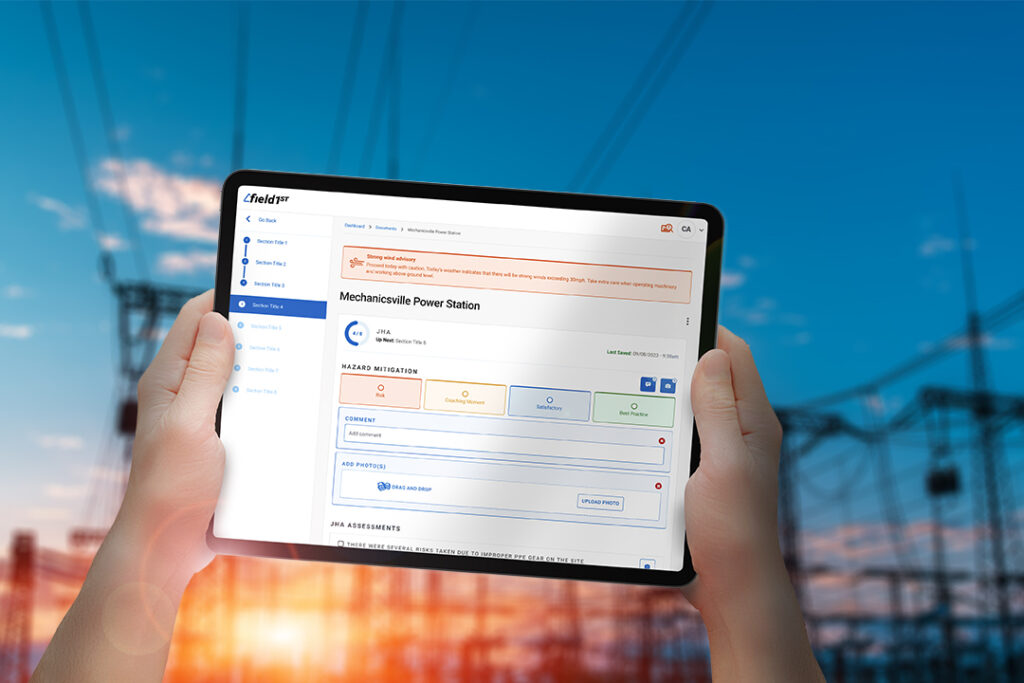Workplace safety is no longer just a legal checkbox—it’s a frontline business necessity. When OSHA compliance is on the line, every missed inspection, undocumented hazard, or delayed audit response can cost far more than just fines. We’re talking about stalled operations, workforce risk, legal liabilities, and reputational damage that lingers.
Manual safety audits? They’re outdated, error-prone, and painfully slow. In 2025, with regulations tightening and work environments getting more complex, modern businesses are trading in clipboards and spreadsheets for smart, automated, mobile-first safety audit software.
This guide breaks down the top five safety audit platforms specifically built to help organizations beat OSHA compliance without drowning in paperwork. Whether you’re overseeing construction crews, managing plant floors, or leading EHS at scale—you’ll walk away knowing exactly what tools give you the edge.
What is safety audit software for OSHA compliance?
Safety audit software for OSHA compliance is a digital solution designed to help businesses conduct regular workplace safety inspections, identify hazards, and ensure adherence to OSHA (Occupational Safety and Health Administration) standards. It streamlines the audit process by digitizing checklists, automating compliance tracking, assigning corrective actions, and generating reports. These tools are essential for safety managers and EHS teams aiming to reduce risks, stay audit-ready, and avoid costly OSHA penalties.
Why OSHA-Focused Audit Software Is a Must-Have in 2025
OSHA violations aren’t rare—they’re everywhere. In 2023 alone, the agency issued over 32,000 citations, with fines ranging from $15,625 per serious violation to over $156,259 for willful/repeat offenses. Most of these incidents weren’t caused by reckless disregard. They were due to lack of visibility, inconsistent processes, or poor documentation.
Safety audit software solves this.
It digitizes your compliance process, gives you real-time audit tracking, and ensures field teams are aligned with what’s happening at HQ. Instead of chasing paper trails or reacting after the damage is done, you’re operating from a place of control and foresight.
When software is built with OSHA in mind, the benefits compound:
- Automated Audit Scheduling & Tracking: Ensuring consistent compliance audits.
- Digital Safety Checklists & Templates: Customizable OSHA-compliant checklists.
- Real-Time Incident Reporting & Analytics: Identifying and addressing safety risks.
- Regulatory Compliance Management: Keeping track of OSHA, ISO 45001, and other safety standards.
- Mobile Accessibility & Cloud Integration: Allowing audits on-site from any device.
This is how leading safety teams are flipping the script—from reactive to proactive.
Comparison Table: OSHA Audit Software Features
| Field1st | Safety Culture | Urbint | Sitemate | GOcanvas | |
|---|---|---|---|---|---|
| Primary functionality | OSHA-focused audits, inspections & compliance | Checklist-driven mobile inspections | Predictive risk management for field safety | Digitizing forms, safety logs, workflows | Custom mobile forms for safety, ops, compliance |
| Integration | API access, ERP, HRIS, LMS, custom integrations | Slack, Teams, Zapier | GIS systems, custom enterprise setups | PDF, email workflows, cloud storage | API access, CRM systems, 3rd-party integrations |
| Customization | Highly configurable workflows, templates | Moderate customization of templates | Custom dashboards and scoring | Drag-and-drop builder, flexible forms | Fully customizable mobile form builder |
| AI features | Predictive analytics for near-miss detection | Limited | AI-powered threat prediction & risk scoring | Limited | None |
| Real-time assistance | Mobile capture, offline sync, issue auto-escalation | Real-time inspection logging & alerts | Real-time field-level risk mapping | Mobile access with offline sync | Mobile workflows, conditional logic, auto-routing |
| Customer Service | Enterprise-level onboarding and dedicated support | Online support, chat, documentation | Enterprise account support only | Email and support | Chat, knowledge base, and custom onboarding |
| Pricing | Custom enterprise pricing | Free plan, Paid starts $24/user/month | Enterprise quote required | Starts at $20/user/month | Starts around $45/user/month |
Top 5 Safety Audit Software for OSHA Compliance in 2025
1. Field1st
Overview:
Field1st is purpose-built for high-risk industries where OSHA compliance isn’t optional—it’s mission-critical. The platform gives EHS managers real-time visibility across job sites, predictive analytics to identify hazards before they happen, and powerful automation to handle audits, inspections, and incident follow-ups.
Key Features:
- OSHA-Compliant Safety Management: Offers fully customizable, regulation-aligned audit checklists and reporting tools tailored to OSHA and ISO standards—ideal for compliance-heavy industries like construction, utilities, and logistics.
- Mobile-First Inspections & Incident Reporting: Enables real-time field audits, mobile inspections, and on-site incident capture—even offline—ensuring immediate documentation and faster response times in remote or hazardous environments.
- Automated Workflows & Escalations: Built-in task assignment, reminders, and escalation protocols transform incident management into a closed-loop system, ensuring follow-ups aren’t forgotten and nothing falls through the cracks.
- Predictive Safety Analytics: Leverages AI to detect patterns, highlight safety hotspots, and anticipate potential hazards before they escalate—empowering teams to act proactively, not reactively.
- Field Engagement & Usability: Designed with intuitive UX for field crews, making it easy for frontline workers to log observations, participate in audits, and stay aligned with compliance—no IT training required.
- Offline Functionality: Field1st works without a signal and syncs data when back online, ensuring uninterrupted safety tracking across remote or signal-poor environments.
Why It Wins:
Field1st combines the rigor of compliance management with the speed and agility of modern SaaS. Its intuitive mobile app empowers field crews to participate in the safety process, not just react to it. For compliance-heavy industries like utilities, construction, or logistics, it’s a game-changer.
Best For:
Enterprises and mid-sized teams with high-risk job sites and strict regulatory environments.
2. SafetyCulture (iAuditor)
Overview:
iAuditor is a mobile-first inspection tool known for its ease of use and rich template library. While not OSHA-specific, it’s highly adaptable for teams looking to digitize safety audits and inspections.
Key Features:
- Template-Driven Inspections: Comes with a massive library of pre-built safety, quality, and operational checklists that can be tailored to suit any industry or audit focus.
- Mobile Audit & Inspection Tools: Empowers teams to perform inspections on smartphones or tablets with real-time data syncing—making it ideal for on-the-go safety reviews across multiple sites.
- Customizable Checklists: Offers no-code editing for checklists and forms, allowing users to create, modify, and scale safety protocols without technical support.
- Team Collaboration & Action Management: Enables teams to flag issues, assign corrective actions, and track resolution directly within the platform—streamlining communication across departments.
- Basic Reporting & Dashboards: Includes centralized dashboards to monitor completed inspections and logged incidents, with exportable data for audits or reporting.
- Flexible Deployment: Easy to implement and train, making it a great fit for small to mid-sized organizations looking to transition away from paper-based inspections.
Why It Wins:
It’s perfect for teams just starting to digitize their audit process. No-code customization, easy rollouts, and flexible integrations make it ideal for small-to-midsize orgs with growing safety needs.
Best For:
Organizations seeking an easy entry point into digital safety audits.
3. Urbint
Overview:
Urbint stands out for its predictive capabilities. It’s less focused on traditional audits and more on anticipating risk using AI and geospatial data. Think of it as a safety early-warning system.
Key Features:
- AI-Powered Risk Prediction: Uses machine learning models trained on historical safety data to forecast where and when incidents are most likely to occur—empowering proactive risk mitigation.
- Geospatial Risk Heatmaps: Visualizes vulnerabilities using GIS overlays and real-time data, helping teams pinpoint high-risk zones across large or dispersed territories.
- Asset-Level Risk Scoring: Provides granular safety insights by evaluating individual assets—like pipelines, transformers, or trench sites—for potential failure or hazard exposure.
- Field Intelligence Integration: Pulls from field reports, environmental conditions, and historical data to build a dynamic risk profile for utility, energy, and infrastructure operations.
- High-Risk Activity Focus: Specializes in critical operations such as trenching, excavation, and overhead work, delivering targeted prevention tools where failure risk is highest.
- Industry-Specific Customization: Built with the operational realities of gas, electric, telecom, and water utilities in mind—ensuring the platform aligns with industry needs and regulatory standards.
Why It Wins:
Urbint doesn’t just help you respond faster—it helps you prevent incidents altogether. For companies managing high-risk infrastructure, Urbint’s intelligence is like giving your safety manager a crystal ball.
Best For:
Large-scale utility, energy, and infrastructure firms with dispersed assets and high-risk environments.
4. Sitemate (Dashpivot)
Overview:
Sitemate’s Dashpivot is built to digitize job site forms, workflows, and documents. It’s ideal for companies looking to bring operational rigor to field documentation without losing flexibility.
Key Features:
- Custom Digital Form Builder: Offers an intuitive drag-and-drop interface to create site-specific forms for inspections, permits, audits, and more—no coding required.
- Workflow Automation & Sign-Offs: Streamlines daily operations with automated approvals, digital signatures, and real-time task routing—keeping projects on schedule and compliant.
- Centralized Document Control: Ensures version-controlled access to forms, safety records, and logs—so teams are always working from the latest documents.
- Safety Log Management: Allows teams to record, categorize, and track safety incidents or observations directly from the field with time-stamped accuracy.
- Offline Functionality with Auto-Sync: Supports remote job sites by enabling form completion without internet access, syncing data automatically once reconnected.
- Project-Centric Flexibility: Designed to scale across multiple job sites and teams, making it easy for field crews and PMs to standardize documentation without heavy IT support.
Why It Wins:
Sitemate strikes a balance between simplicity and structure. You can go live quickly, train teams easily, and start capturing OSHA-relevant data without major IT overhead.
Best For:
Contractors, builders, and project managers who want an agile field documentation solution.
5. GoCanvas
Overview:
GoCanvas is a digital form builder that’s incredibly customizable. While it’s not designed solely for OSHA compliance, it’s powerful when tailored for safety audits.
Key Features:
- Mobile Form Builder: Easily design custom digital forms with a drag-and-drop interface—ideal for tailoring safety checklists, inspections, and audit flows to your exact needs.
- Multimedia Data Capture: Enables field users to attach photos, capture GPS data, and collect digital signatures directly within forms—perfect for incident verification and documentation.
- Automated Submission & Routing: Routes completed forms to the right stakeholders instantly with built-in workflows, keeping reviews and approvals on track.
- Integration-Ready: Offers robust API access and connects with platforms like Salesforce, Box, or Google Sheets to sync safety data across systems.
- Cross-Department Flexibility: Supports use cases beyond safety—HR, logistics, field service, and operations can all leverage GoCanvas for form-based workflows.
Why It Wins:
You’re not boxed into one format or process. Build your own OSHA-ready checklists, inspection flows, and reports—and scale across teams without breaking the system.
Best For:
Companies that need custom-built safety workflows that fit their unique operations.
How to Choose the Right OSHA-Compliant Safety Audit Software
Choosing the right platform isn’t about bells and whistles—it’s about operational fit. Here’s how to evaluate software through the lens of OSHA compliance and business impact.
1. Compliance-Centered Features
Can the software handle OSHA’s specific requirements? Look for tools with prebuilt OSHA-aligned checklists, audit scheduling, and auto-reminders that track recurring inspections.
2. Customization Capabilities
Your workflows are unique. The best software doesn’t force you to adapt—it molds around your teams. Whether it’s custom SOPs, multi-site reporting, or varying inspection cadences, flexibility is key.
3. Mobile-First Access
Field crews must be able to complete audits on the fly, regardless of connectivity. Offline support, sync-on-reconnect, and responsive design are non-negotiables in 2025.
4. Escalation and Corrective Action Automation
What happens when a hazard is flagged? The best platforms immediately notify the right personnel, track action items, and close the loop automatically.
5. Real-Time Visibility
Compliance should never be a black box. Dashboards showing audit status, high-risk zones, overdue actions, and trendlines help safety leaders get ahead—not just react.
6. Scalability and Integrations
Can it grow with you? If you’re expanding to new sites, departments, or regions, make sure the system can scale—ideally with integrations into your HRIS, ERP, and LMS.
7. Support and Training
Even the best software fails without buy-in. Choose vendors with live onboarding, training sessions, knowledge base support, and ongoing account success check-ins.
Why Field1st is Trusted by Top Enterprises
When it comes to OSHA compliance, not all safety audit tools are built the same. In high-risk industries, choosing the right platform isn’t just a tech decision—it’s a safety decision. The wrong software can slow you down, miss red flags, or leave you exposed during an inspection. The right one? It protects your people, keeps you audit-ready, and moves at the speed of your field.
That’s why leading enterprises choose Field1st.
With real-time mobile inspections, automated compliance tracking, predictive analytics, and offline capability, Field1st isn’t just checking boxes—it’s setting the new standard for modern safety management.
For organizations that take OSHA compliance seriously, Field1st delivers the control, visibility, and speed you need—on the job site, in the office, or across your entire operation.
Quick Summary: Why OSHA Safety Audit Software Matters
- OSHA fines are steep, and enforcement is increasing
- Manual audits slow you down and open risk exposure
- Top software platforms turn compliance into a real-time process
- Field1st stands out for high-risk industries needing enterprise-level control
- Other options like iAuditor, Urbint, Sitemate, and GoCanvas offer flexibility for different needs
Digital safety isn’t the future. It’s the present. Equip your team with the tools that lead to fewer incidents, faster audits, and a safer workplace—every single day.
Start today.
Your Next Step
Ready to stop chasing compliance and start owning it?
Schedule a Field1st demo today
Give your safety team the tools they need to work smarter, faster, and safer—in every audit, every inspection, and every single day.





